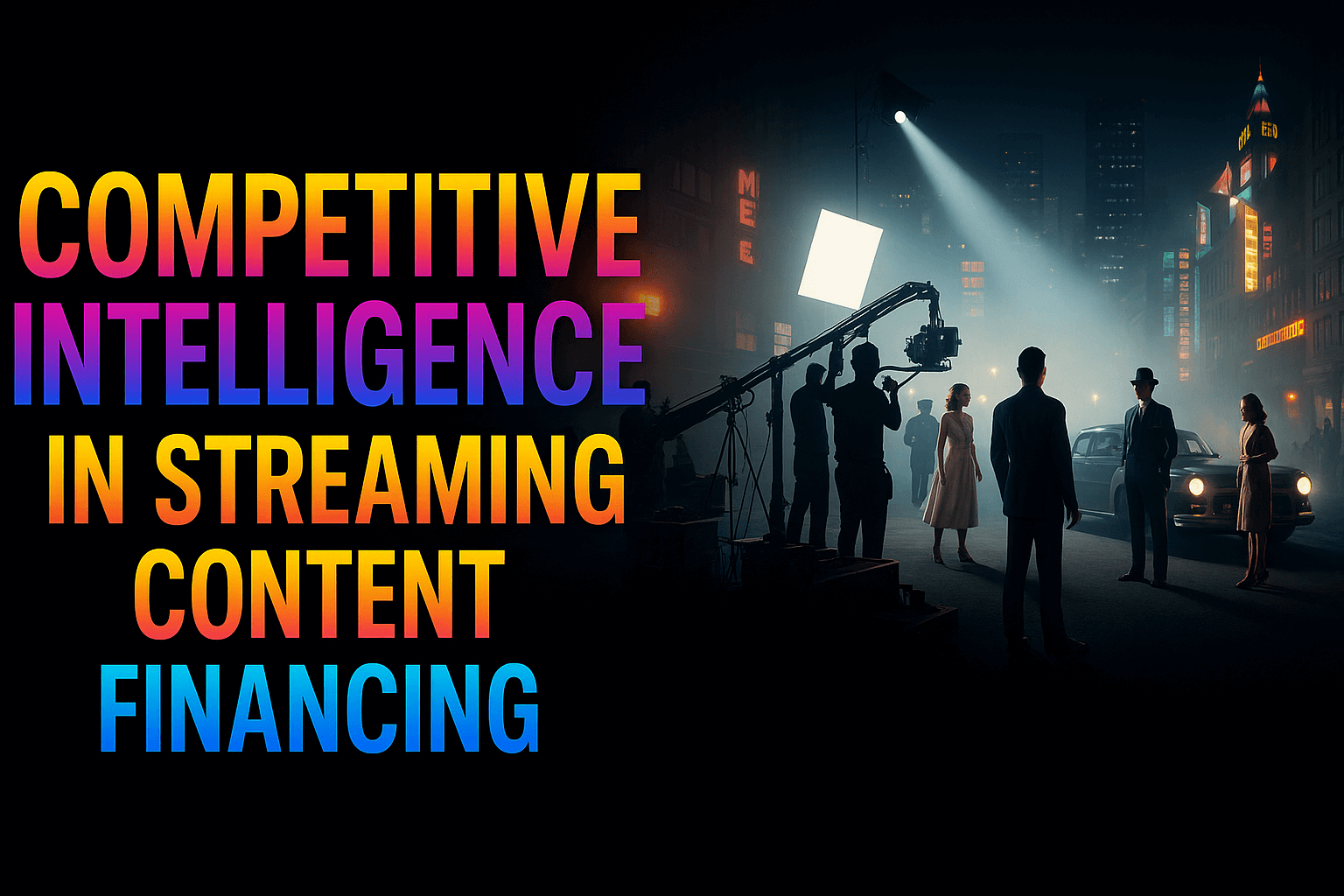The Ultimate Guide to Competitive Intelligence in Streaming Content Financing

Introduction
The modern media and entertainment (M&E) landscape is defined by its complexity and pace. A proliferation of streaming platforms, a constant need for fresh content, and the high-stakes world of content financing have created an environment where traditional methods of market analysis are no longer sufficient.
For executives responsible for financing film and TV projects, success hinges not just on creative intuition, but on access to a deep, verifiable stream of information about what is being produced, by whom, and at what stage.
This is the new strategic imperative: competitive intelligence in streaming content financing. This comprehensive guide will dissect the concept, explore the critical challenges you face, and provide a framework for building a modern competitive intelligence function that can help you secure a strategic advantage. I will break down the key challenges and present a new operational model.
Key Takeaways
| Core Challenge | Legacy research methods fail to provide a single, unified view of the global entertainment supply chain, leading to missed opportunities and inefficient deals. |
| Strategic Solution | Implement a modern competitive intelligence framework that uses real-time, verified data to track projects, companies, and collaborations. |
| Vitrina’s Role | Vitrina serves as the single source of truth, centralizing fragmented data and providing the critical intelligence required for smart content financing decisions. |
The Strategic Imperative: Why Competitive Intelligence is a Must-Have in Content Financing
The film and television industry is no longer a closed-loop system dominated by a few major studios. It is an intricate, interconnected global network of production companies, studios, financiers, and distributors, all vying for a limited pool of audience attention and capital.
The rise of direct-to-consumer streaming has intensified this competition, placing immense pressure on financing executives to identify valuable projects earlier in the pipeline. In this environment, competitive intelligence isn’t a luxury; it’s a foundational element of a sound strategy.
Effective competitive intelligence in streaming content financing allows an organization to move beyond a reactive stance. Instead of waiting for a project to be announced or pitched, you can proactively identify emerging trends, track the development slate of competitors, and discover new, vetted partners.
This forward-looking approach is essential for mitigating risk and capitalizing on opportunities that manual, ad-hoc research simply cannot uncover. Without a formal competitive intelligence function, you are operating with incomplete visibility, a situation that can lead to misallocated capital, undervalued deals, or even worse, missing a hit project entirely.
The data signals that matter most to a financier include:
- Project Momentum: Is a project moving from development to production? Are key personnel being attached?
- Creative Team & Collaborators: Who are the key creatives and what is their track record? Which studios or production companies are they working with?
- Financing & Co-Production Partners: Who is funding a project? Are new and interesting co-production partnerships forming that signal a trend?
The Core Challenge: Fragmented Data and the Cost of Ignorance
The biggest obstacle to effective competitive intelligence is not a lack of data, but its extreme fragmentation. The information you need to make an informed decision exists across hundreds of disparate sources—trade publications, IMDbPro, company websites, social media, and more.
For an executive or their team, manually piecing together this puzzle is not only inefficient but fundamentally unreliable. The time and resources spent on this kind of manual research represent a significant, hidden cost to the business.
This data chaos leads to a series of high-level pain points. There is a lack of a single source of truth, meaning different departments may be operating with different information, leading to internal misalignment.
Deals are often based on outdated or incomplete intel. And perhaps most damaging, a lack of deep insight into the market means you could miss a critical, emerging opportunity.
A film financier, for example, may not know that a top-tier showrunner has just signed a first-look deal with a specific production company, or that a co-production partner they were considering for a high-budget project has just had a previous deal with a different studio fall through.
Without a comprehensive view of these hidden connections, you are operating at a disadvantage. This is a primary pain point in the entertainment supply chain that modern technology must solve.
Building a Modern Competitive Intelligence Framework for Content Financing
Building a modern competitive intelligence function requires moving away from the manual data hunt toward a structured, technology-enabled process.
The framework can be broken down into three critical phases:
- Identifying Key Players: Beyond the obvious competitors, who are the emerging production companies, rising talent, and key service providers shaping the market? A comprehensive competitive intelligence strategy tracks the full network of companies and executives, creating a deep understanding of the M&E “ecosystem.”
- Tracking the Supply Chain: Information is most valuable when it’s actionable. This means tracking projects from their initial development phase through pre-production, production, and into distribution. Seeing a project move from an unconfirmed rumor to a formal greenlight with a cast attached is a critical signal for any financier. Vitrina’s platform, for instance, provides a project tracker that delivers this granular, real-time visibility.
- Connecting the Dots: The most powerful insight comes from connecting disparate data points. A successful framework must be able to link a specific project to the companies involved, the executives who greenlit it, and the financing partners who backed it. This network of relationships reveals hidden patterns and provides a strategic map of the industry.
Vitrina: The Single Source of Truth for Entertainment Competitive Intelligence
The strategic framework outlined above is only as effective as the data that powers it. This is where Vitrina comes in. Vitrina is a global platform that tracks the entertainment supply chain—film and TV content, projects, companies, collaborations, and key decision-makers.
It is designed to be the single source of truth for M&E professionals, a critical antidote to the data fragmentation that plagues the industry.
Vitrina’s core capabilities are a direct answer to the challenges of manual research. The platform’s ability to track global film and TV projects from development to release in real time gives financiers an early-warning system for new opportunities.
Its extensive company profiles provide deep intelligence on studios, streamers, co-production partners, and more. By cross-referencing this data, the platform provides a level of detail that is simply unattainable through traditional means.
The result is a powerful tool for competitive intelligence in streaming content financing, offering a clear, strategic advantage to those who use it.
How Vitrina Enables Smarter Content Financing Decisions
Vitrina is not just a database; it’s an operational tool that enables smarter, more confident decision-making.
Here are some specific use cases for how the platform facilitates better content financing outcomes:
- Early Vetting of Co-Production Partners: Imagine you’re considering a new co-production partner. Instead of relying on a single pitch deck, you can use Vitrina to analyze their full deal track record, see which other companies they have collaborated with, and understand their specialization by genre or region. This allows you to identify relevant partners based on verified data, mitigating risk before a deal is even discussed.
- Analyzing a Competitor’s Slate: A financier needs to know what a competitor is investing in. Is a major streamer moving heavily into animated features? Is a rival production company quietly developing a slate of high-budget sci-fi series? Vitrina’s project tracker provides a window into these trends, allowing you to calibrate your own investment strategy in response.
- Identifying Emerging Projects for Pre-Buys: The most lucrative deals often happen long before a project is announced to the public. Vitrina provides visibility into projects in the early development stages, allowing you to identify a potential hit and engage in a pre-buy negotiation before a bidding war even begins.
Competitive intelligence is also a critical component of successful cross-border transactions as it helps vet the reputation and credentials of new partners. Vitrina’s platform provides the data to conduct thorough due diligence, ensuring you are aligning with credible and successful entities.
Conclusion
The future of content financing belongs to those who can master the flow of information. The era of manual, fragmented research is over, replaced by the strategic imperative of competitive intelligence.
By implementing a modern framework and leveraging a single source of truth, such as Vitrina, executives can move beyond guesswork and into a world of confident, data-driven decisions.
The ability to track a project from its nascent stage to its final release, to understand the web of relationships between companies and individuals, and to identify new opportunities before they hit the open market is the key to securing a strategic advantage. Competitive intelligence in streaming content financing is no longer a strategic option—it is a market necessity.
Frequently Asked Questions
Competitive intelligence in the M&E industry is the process of collecting and analyzing data on competitors, market trends, and industry movements. Its goal is to provide a comprehensive, strategic view that informs critical business decisions, from content financing and acquisition to co-production partnerships.
The most critical data includes real-time project tracking (development status, cast, crew), verified company profiles (studios, distributors, vendors), and a network view of collaborations and deal track records. This data provides the core intelligence needed to assess risk and identify opportunities in content financing.
Historically, this has been a manual process involving a team of researchers piecing together information from various publications, databases, and trade shows. Modern companies are now leveraging specialized platforms and AI-powered tools that automate data aggregation and analysis, providing a single source of truth for all competitive insights.
The key benefits include the ability to identify and vet potential co-production partners, discover new investment opportunities earlier in the production pipeline, and gain a holistic view of competitor strategies. It helps mitigate financial risk by ensuring every decision is backed by verified, real-time industry data.

























